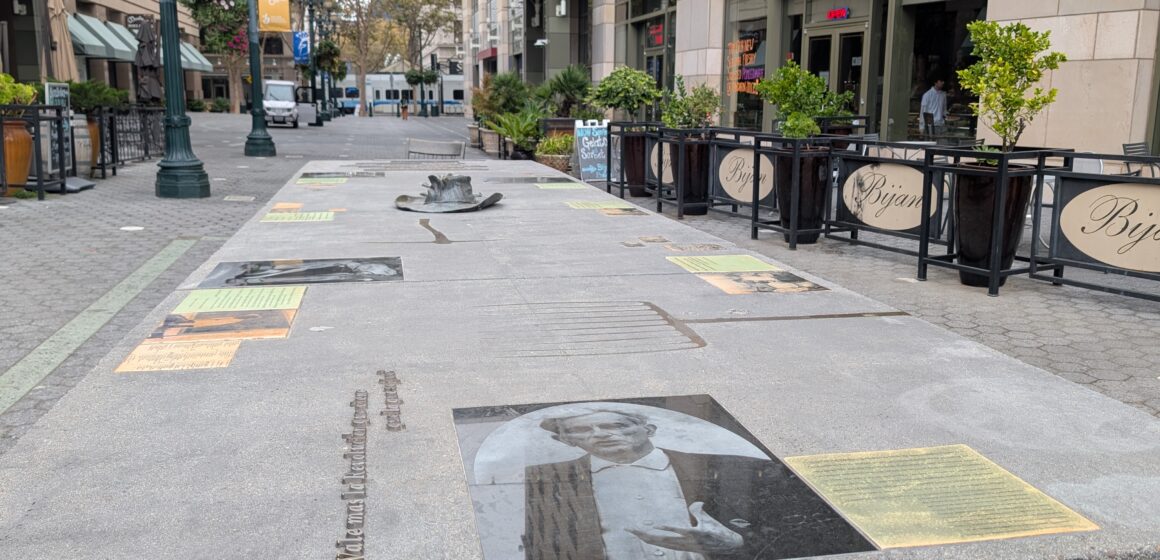We appreciate Joyce Chu’s Oct. 5. article, San Jose path could be renamed for Filipino labor leader, spotlighting the efforts and extraordinary contributions of Larry Itliong. Filipino labor organizers like Itliong played a pivotal, and too often overlooked, role in California’s labor history. Honoring his legacy is long overdue.
But the proposed location — the Paseo de San Antonio — is already home to a dedicated public art monument honoring another pioneering farmworker labor leader: Ernesto Galarza (1905–1984). To rename this walkway would unintentionally displace the memory of a figure whose scholarship and activism helped lay the groundwork for the very labor struggles Larry Itliong would later lead.
The Paseo’s existing artwork, “A Man of Fire” by Kim Yasuda, was dedicated on Sept. 16, 1998 by Max Crumley, former chair of the San Jose Arts Commission, former Mayor Susan Hammer and former San Jose State University President Robert Caret. This four-block artwork installation begins at South Market Street and extends along the Paseo with eight bilingual plaques telling Dr. Galarza’s story — from his arrival in San Jose in the 1940s to his lifelong work as a scholar, poet and advocate for farmworker justice. Paseo de San Antonio honors Saint Anthony of Padua (Portugal), venerated in the old and new world as a scholar and protector of farmers and livestock.
Galarza was among the first to organize farmworkers across racial and gender lines. As 1940s and 1960s director of the National Farm Labor Union (AFL-CIO), he led more than 20 major strikes involving Filipino, Mexican, and white American men and women workers. His early campaigns against corporate “Agri-business” and his groundbreaking critiques of the Bracero Program paved the way for later successful movements and unions led by Itliong, Cesar Chavez and Dolores Huerta.
A resident of San Jose’s Willow Glen neighborhood, Galarza authored influential books such as “Spiders in the House & Workers in the Field” and “Farm Workers and Agri-Business in California 1947-1960,” as well as bilingual children’s literature. He was a visiting scholar at several universities including San Jose State and remained deeply involved in local community, education and advocacy until his death in 1984.
We wholeheartedly support efforts to honor Larry Itliong and other Filipino labor pioneers. However, we urge the city to find an alternative site for such a tribute — one that uplifts Itliong’s name without erasing a long-established memorial to his predecessor. San Jose has the opportunity to celebrate farmworker labor history in ways that reflect the city’s inclusive and richly multicultural history.
To aid in this effort, we’ve shared several short educational videos we produced about both leaders and the existing artwork installation:
- Filipino Leader: A Labor Day Salute to Our Filipino Brothers and Sisters (2014)
- Dr. Ernesto Galarza: Man of Fire, Mexican San Jose, CA (2014)
- Ernesto Galarza, Ph.D.: San Jose’s Scholar Activist (2022)
- Visita De La Familia De Ernesto Galarza A San Jose, California (2016)
We invite city officials, artists and community members to collaborate with us on a shared vision — one that honors both Larry Itliong and Ernesto Galarza and others as part of San Jose’s proud legacy of farmworker justice.
Jesús L. Orosco is a San Jose State University alumnus and president of the La Raza Historical Society of Santa Clara Valley. Gregorio Mora-Torres, Ph.D. is a historian and San Jose State University emeritus faculty of Chicana and Chicano Studies. Ramon J. Martínez, Ph.D. is a San Jose State University alumnus, founding board member of La Raza Historical Society of Santa Clara Valley and videographer. They can be contacted at [email protected], [email protected] and [email protected].



Leave a Reply
You must be logged in to post a comment.